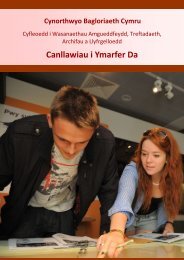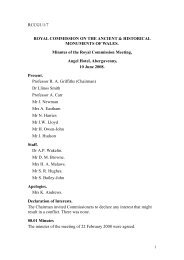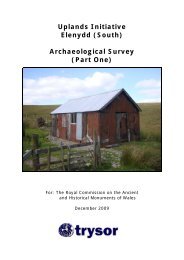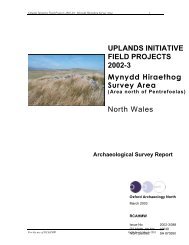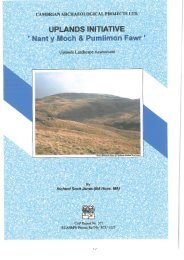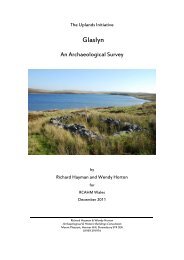Cwm Prysor (Merionethshire) - Royal Commission on the Ancient ...
Cwm Prysor (Merionethshire) - Royal Commission on the Ancient ...
Cwm Prysor (Merionethshire) - Royal Commission on the Ancient ...
Create successful ePaper yourself
Turn your PDF publications into a flip-book with our unique Google optimized e-Paper software.
ArcHeritage 15vary c<strong>on</strong>siderably in terms of preservati<strong>on</strong>. In some cases, <strong>on</strong>ly st<strong>on</strong>y banks or single coursesof st<strong>on</strong>e walls survive, whereas o<strong>the</strong>rs have been kept in good repair, or have been modifiedthrough <strong>the</strong> additi<strong>on</strong> of wire fences.IndustrialPost-medieval industrial features include quarries, mines and peat cuttings, as well as apossible kiln at Craig y Ffolt. Quarrying appears to have been undertaken mainly for buildingst<strong>on</strong>e and slate, including for <strong>the</strong> c<strong>on</strong>structi<strong>on</strong> of field boundary walls. Some of <strong>the</strong> quarryingremains suggest that extracti<strong>on</strong> of quartz was also a factor. The quarries vary in size from smallst<strong>on</strong>e extracti<strong>on</strong> hollows to rock faces over 50m in length. Quarrying may be over-representedin <strong>the</strong> surveyed sites, as <strong>the</strong> patterns of natural fracturing of exposed rock faces producessimilar features to those related to deliberate extracti<strong>on</strong> of st<strong>on</strong>e. Where it is unclear, this hasbeen noted in <strong>the</strong> short text descripti<strong>on</strong>s. The larger quarries tend to be located to <strong>the</strong> northof <strong>the</strong> Af<strong>on</strong> Gain, around Gelli Gain, Pig Idris and Moel Oernant (Plate 13).Mining remains comprise 34 sites recorded during <strong>the</strong> survey. The majority of mining remainsare located <strong>on</strong> <strong>the</strong> slopes to <strong>the</strong> north and south of Moel Ddu, at Ffrîdd Ddu and Llyn GelliGain, with o<strong>the</strong>r small groups at Nant Cae-Gwair, Nant Braich y Ceunant and Bryn yr Helfa. Theremains generally comprise linear hollows leading towards shaft openings in <strong>the</strong> face ofhillsides (Plate 14). Five of <strong>the</strong> sites appear to be associated with gold mines recorded <strong>on</strong> <strong>the</strong>HER (531287, 531322, 531335, 531509-510), whilst o<strong>the</strong>rs at Af<strong>on</strong> Gain and Nant Braich yCeunant are shown <strong>on</strong> historic OS maps as trial copper mines (NPRN 530876, 531100-531102).The exact date of <strong>the</strong> mining activity is unclear, but in some cases shafts appear to have beenexcavated and aband<strong>on</strong>ed between <strong>the</strong> 1899 and 1901 OS surveys. Some of <strong>the</strong> workings arenot shown <strong>on</strong> any maps and may represent prospecti<strong>on</strong>.The largest number of sites in <strong>the</strong> industrial category comprise peat cuttings. These featuresmay be over-represented, as in some cases it was difficult to distinguish natural peat erosi<strong>on</strong>from deliberate peat cutting. Where this was <strong>the</strong> case, it has been noted in <strong>the</strong> short textdescripti<strong>on</strong>. Peat cuttings were widely distributed across <strong>the</strong> survey area, at altitudes from300m to 549m aOD.TransportTransport features comprise track ways, hollow ways and bridges. Hollow ways representroutes defined by a worn hollow, sometimes with banks to ei<strong>the</strong>r side, whereas track waystend to be level or terraced features with no distinct hollow, and sometimes with gravelsurfacing. The features included well-established farm tracks or post-medieval routes to andfrom farmsteads (Plate 15), as well as routes which may have been associated with industrialextracti<strong>on</strong>.5.2.5 ModernThe survey identified 295 modern or probably modern sites. These can mainly be broken downinto two broad categories: farm infrastructure features (field boundaries, sheep folds, p<strong>on</strong>ds,bridges, culverts); and defence (practice trenches, weap<strong>on</strong>s pits, firing range blockhouses,military roads, telecommunicati<strong>on</strong> structures). The locati<strong>on</strong>s of all modern sites are shown <strong>on</strong>Figure 6, with defence-related sites and <strong>the</strong> extent of <strong>the</strong> military range shown <strong>on</strong> Figure 7.<str<strong>on</strong>g>Cwm</str<strong>on</strong>g> <str<strong>on</strong>g>Prysor</str<strong>on</strong>g> Upland SurveyArcHeritage Survey Report Report No 2013/8


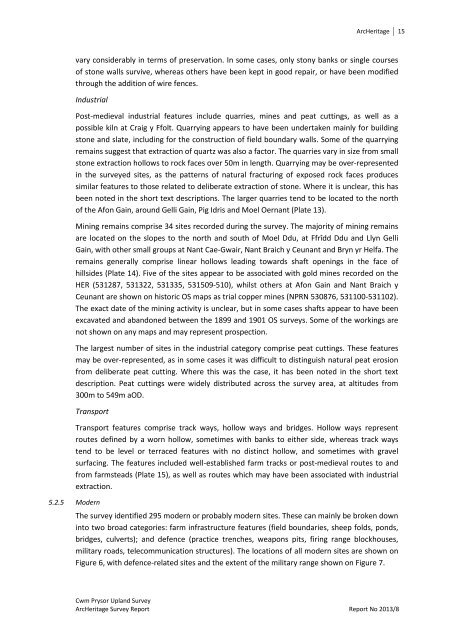

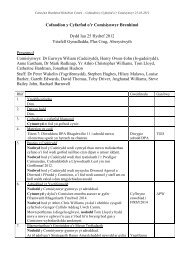
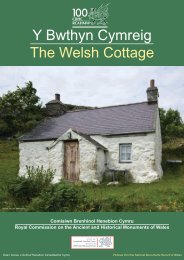

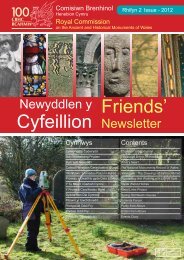
![The Source of the Usk Walk [2012 PDF]](https://img.yumpu.com/49285699/1/190x245/the-source-of-the-usk-walk-2012-pdf.jpg?quality=85)

